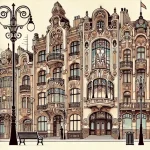Art Nouveau in Maribor, Slovenia
Art Nouveau in Maribor, Slovenia emerged during the late 19th and early 20th centuries, when the city was experiencing rapid urban development under the Austro-Hungarian Empire. Although Maribor is not as widely recognized for Art Nouveau as Ljubljana or Vienna, it still hosts several notable examples that reflect the movement’s characteristic elegance, craftsmanship, and organic inspiration.
In Maribor, Art Nouveau—locally referred to as secesija—often appears in residential and commercial buildings constructed between 1895 and 1915. These structures typically feature softly curved façades, floral ornamentation, wrought-iron balconies, and decorative stucco panels that echo natural forms. Many of these motifs were influenced by Viennese Secession design, which favoured geometric stylization and a slightly more restrained decorative vocabulary compared to the more exuberant French or Belgian Art Nouveau.
Key streets in the city center, especially around the Glavni trg and along Slovenska ulica, showcase buildings with secessionist elements: elegant entrance portals, rhythmic window arrangements, and ornamental details such as stylized sunbursts or botanical reliefs. Some examples blend Art Nouveau with Historicist or early Modernist influences, resulting in hybrid façades that demonstrate Maribor’s transitional architectural identity during this period.
Art Nouveau in Maribor represents both aesthetic innovation and the city’s aspirations at the turn of the century. It marked a shift toward modern urban living, reflected in improved housing standards, new commercial enterprises, and a growing middle class. Today, these buildings contribute to Maribor’s architectural richness, offering a visually engaging layer of its cultural heritage and connecting the city to the wider Central European Secessionist movement.
